Statistical Analysis on Clinical Trial Report
VerifiedAdded on 2020/04/15
|15
|2864
|31
AI Summary
Contribute Materials
Your contribution can guide someone’s learning journey. Share your
documents today.
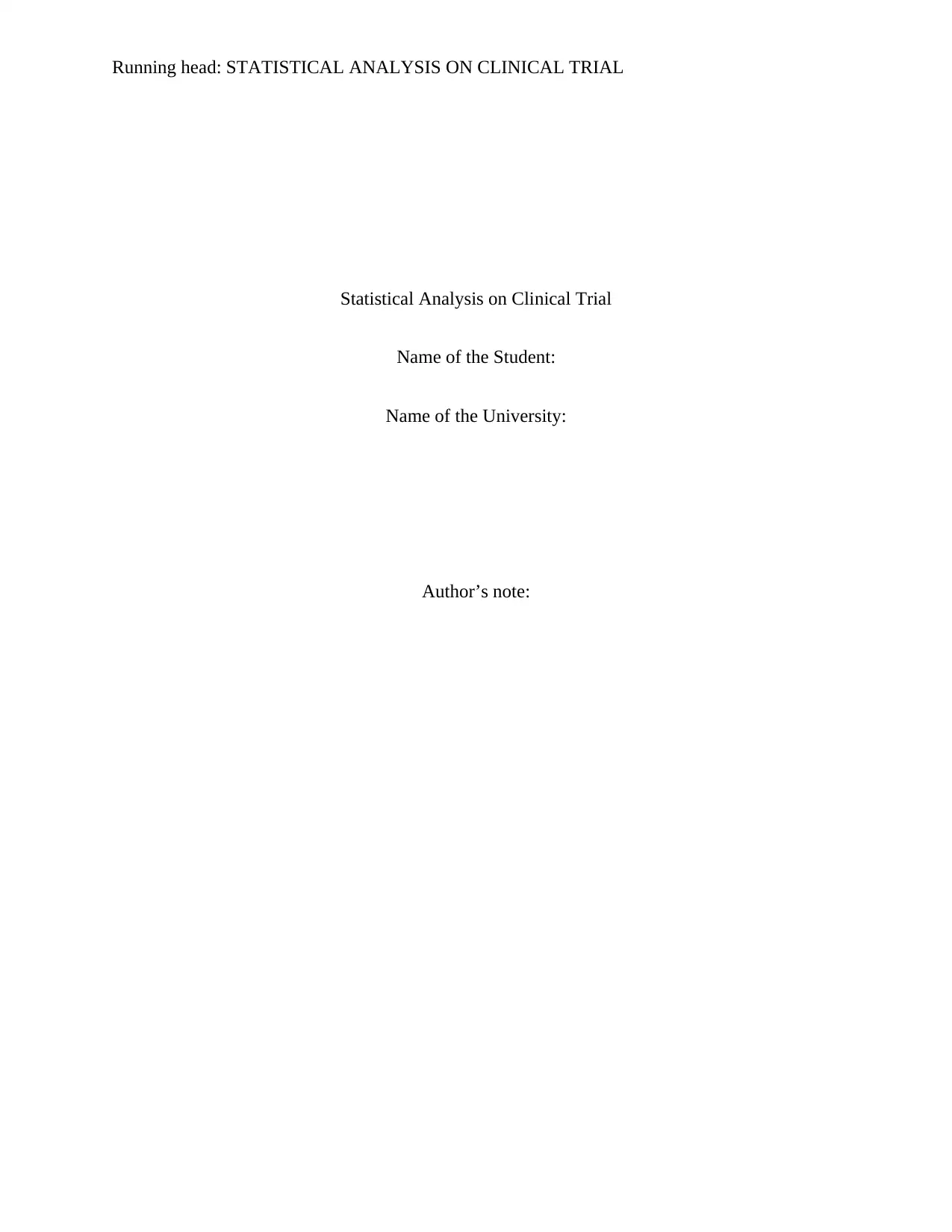
Running head: STATISTICAL ANALYSIS ON CLINICAL TRIAL
Statistical Analysis on Clinical Trial
Name of the Student:
Name of the University:
Author’s note:
Statistical Analysis on Clinical Trial
Name of the Student:
Name of the University:
Author’s note:
Secure Best Marks with AI Grader
Need help grading? Try our AI Grader for instant feedback on your assignments.

1STATISTICAL ANALYSIS ON CLINICAL TRIAL
Executive Summary:
This report is initially designed to measure the influence of non-operative treatment of hip and
knee osteoarthritis using two kinds of infiltrations. A comparison is structured from control-
group infiltration. By establishing the study design, researchers would like to contribute a
specific research on non-operative treatment of osteoarthritis of the knee and hip to prevail bias
for the double-blinded randomized trial. The report is based on data collection, data analysis and
interpretation of the data. The measure at the time of enrolment of the research prior to injection
or baseline is administered and followed-up for three or six months. The recovery of patients
according to the two different doses is analysed and determined.
Executive Summary:
This report is initially designed to measure the influence of non-operative treatment of hip and
knee osteoarthritis using two kinds of infiltrations. A comparison is structured from control-
group infiltration. By establishing the study design, researchers would like to contribute a
specific research on non-operative treatment of osteoarthritis of the knee and hip to prevail bias
for the double-blinded randomized trial. The report is based on data collection, data analysis and
interpretation of the data. The measure at the time of enrolment of the research prior to injection
or baseline is administered and followed-up for three or six months. The recovery of patients
according to the two different doses is analysed and determined.
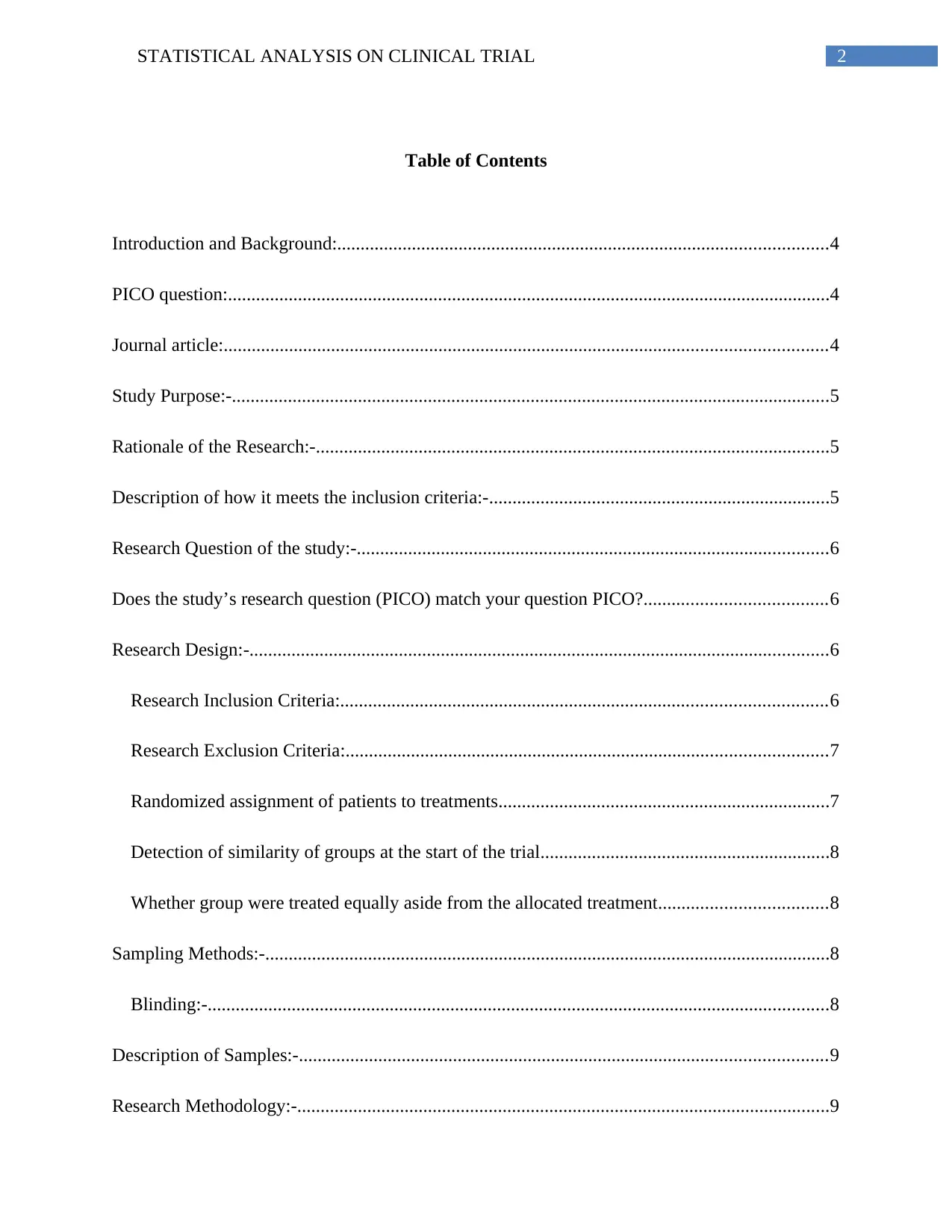
2STATISTICAL ANALYSIS ON CLINICAL TRIAL
Table of Contents
Introduction and Background:.........................................................................................................4
PICO question:.................................................................................................................................4
Journal article:.................................................................................................................................4
Study Purpose:-................................................................................................................................5
Rationale of the Research:-..............................................................................................................5
Description of how it meets the inclusion criteria:-.........................................................................5
Research Question of the study:-.....................................................................................................6
Does the study’s research question (PICO) match your question PICO?.......................................6
Research Design:-............................................................................................................................6
Research Inclusion Criteria:........................................................................................................6
Research Exclusion Criteria:.......................................................................................................7
Randomized assignment of patients to treatments.......................................................................7
Detection of similarity of groups at the start of the trial..............................................................8
Whether group were treated equally aside from the allocated treatment....................................8
Sampling Methods:-.........................................................................................................................8
Blinding:-.....................................................................................................................................8
Description of Samples:-.................................................................................................................9
Research Methodology:-..................................................................................................................9
Table of Contents
Introduction and Background:.........................................................................................................4
PICO question:.................................................................................................................................4
Journal article:.................................................................................................................................4
Study Purpose:-................................................................................................................................5
Rationale of the Research:-..............................................................................................................5
Description of how it meets the inclusion criteria:-.........................................................................5
Research Question of the study:-.....................................................................................................6
Does the study’s research question (PICO) match your question PICO?.......................................6
Research Design:-............................................................................................................................6
Research Inclusion Criteria:........................................................................................................6
Research Exclusion Criteria:.......................................................................................................7
Randomized assignment of patients to treatments.......................................................................7
Detection of similarity of groups at the start of the trial..............................................................8
Whether group were treated equally aside from the allocated treatment....................................8
Sampling Methods:-.........................................................................................................................8
Blinding:-.....................................................................................................................................8
Description of Samples:-.................................................................................................................9
Research Methodology:-..................................................................................................................9
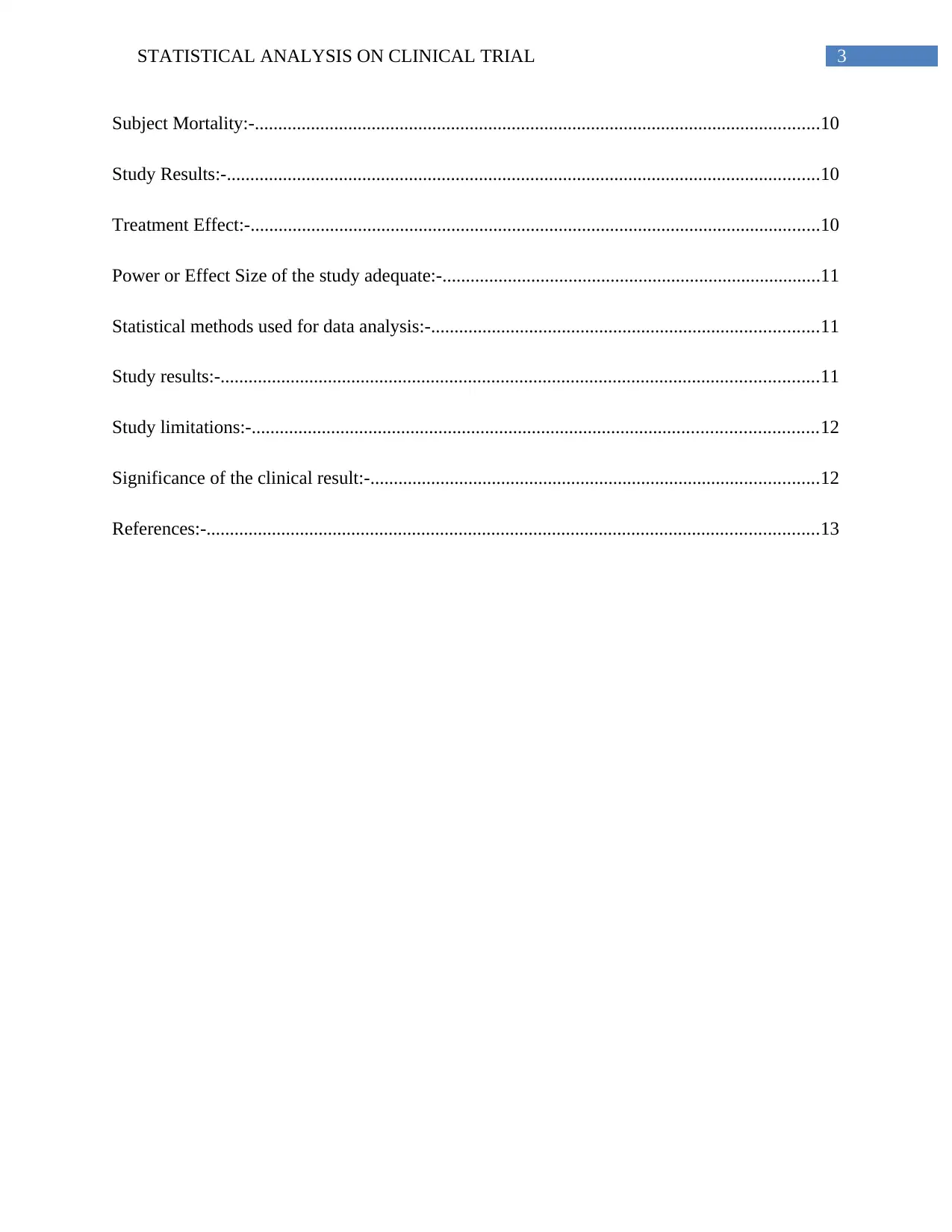
3STATISTICAL ANALYSIS ON CLINICAL TRIAL
Subject Mortality:-.........................................................................................................................10
Study Results:-...............................................................................................................................10
Treatment Effect:-..........................................................................................................................10
Power or Effect Size of the study adequate:-.................................................................................11
Statistical methods used for data analysis:-...................................................................................11
Study results:-................................................................................................................................11
Study limitations:-.........................................................................................................................12
Significance of the clinical result:-................................................................................................12
References:-...................................................................................................................................13
Subject Mortality:-.........................................................................................................................10
Study Results:-...............................................................................................................................10
Treatment Effect:-..........................................................................................................................10
Power or Effect Size of the study adequate:-.................................................................................11
Statistical methods used for data analysis:-...................................................................................11
Study results:-................................................................................................................................11
Study limitations:-.........................................................................................................................12
Significance of the clinical result:-................................................................................................12
References:-...................................................................................................................................13
Secure Best Marks with AI Grader
Need help grading? Try our AI Grader for instant feedback on your assignments.
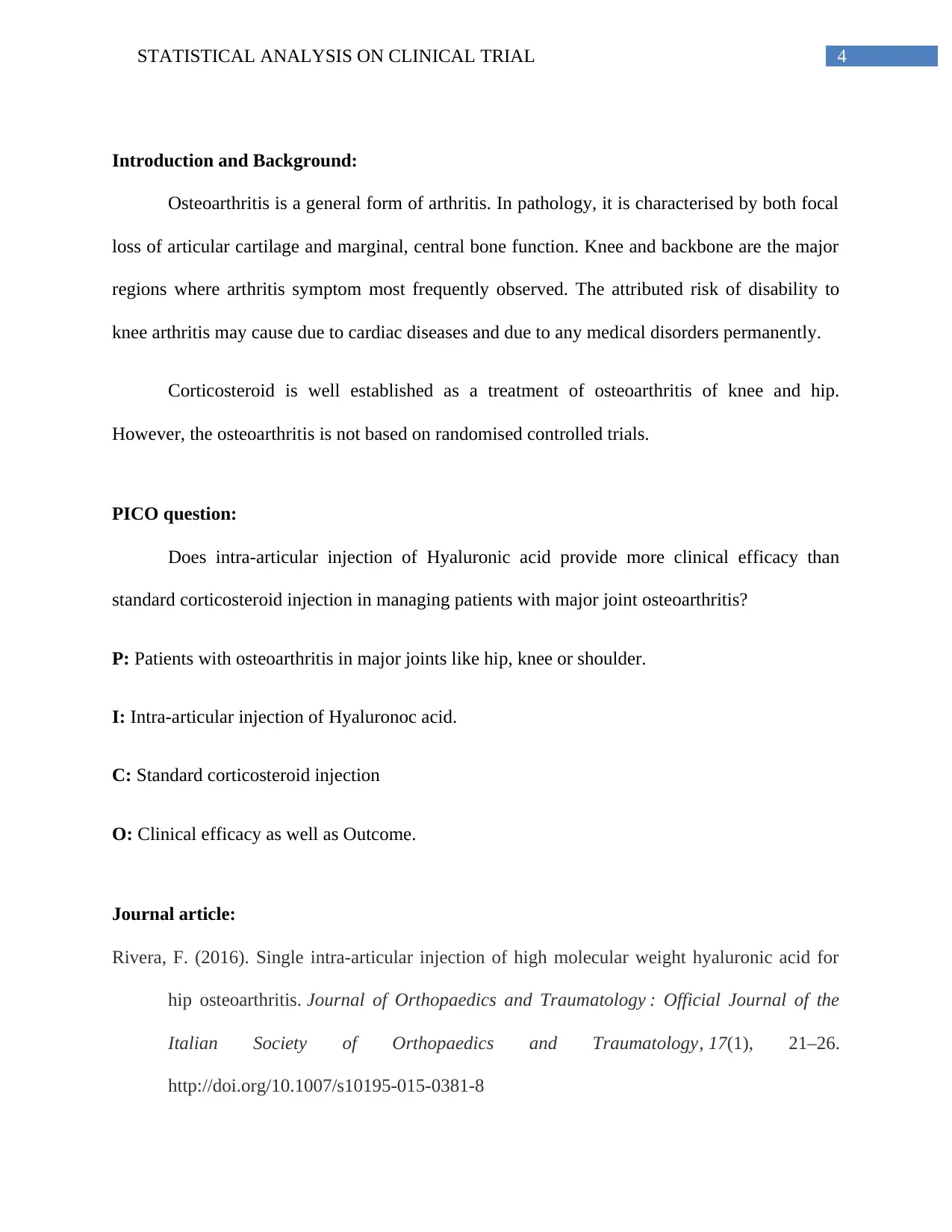
4STATISTICAL ANALYSIS ON CLINICAL TRIAL
Introduction and Background:
Osteoarthritis is a general form of arthritis. In pathology, it is characterised by both focal
loss of articular cartilage and marginal, central bone function. Knee and backbone are the major
regions where arthritis symptom most frequently observed. The attributed risk of disability to
knee arthritis may cause due to cardiac diseases and due to any medical disorders permanently.
Corticosteroid is well established as a treatment of osteoarthritis of knee and hip.
However, the osteoarthritis is not based on randomised controlled trials.
PICO question:
Does intra-articular injection of Hyaluronic acid provide more clinical efficacy than
standard corticosteroid injection in managing patients with major joint osteoarthritis?
P: Patients with osteoarthritis in major joints like hip, knee or shoulder.
I: Intra-articular injection of Hyaluronoc acid.
C: Standard corticosteroid injection
O: Clinical efficacy as well as Outcome.
Journal article:
Rivera, F. (2016). Single intra-articular injection of high molecular weight hyaluronic acid for
hip osteoarthritis. Journal of Orthopaedics and Traumatology : Official Journal of the
Italian Society of Orthopaedics and Traumatology, 17(1), 21–26.
http://doi.org/10.1007/s10195-015-0381-8
Introduction and Background:
Osteoarthritis is a general form of arthritis. In pathology, it is characterised by both focal
loss of articular cartilage and marginal, central bone function. Knee and backbone are the major
regions where arthritis symptom most frequently observed. The attributed risk of disability to
knee arthritis may cause due to cardiac diseases and due to any medical disorders permanently.
Corticosteroid is well established as a treatment of osteoarthritis of knee and hip.
However, the osteoarthritis is not based on randomised controlled trials.
PICO question:
Does intra-articular injection of Hyaluronic acid provide more clinical efficacy than
standard corticosteroid injection in managing patients with major joint osteoarthritis?
P: Patients with osteoarthritis in major joints like hip, knee or shoulder.
I: Intra-articular injection of Hyaluronoc acid.
C: Standard corticosteroid injection
O: Clinical efficacy as well as Outcome.
Journal article:
Rivera, F. (2016). Single intra-articular injection of high molecular weight hyaluronic acid for
hip osteoarthritis. Journal of Orthopaedics and Traumatology : Official Journal of the
Italian Society of Orthopaedics and Traumatology, 17(1), 21–26.
http://doi.org/10.1007/s10195-015-0381-8

5STATISTICAL ANALYSIS ON CLINICAL TRIAL
Study Purpose:-
The aetiology of Osteoarthritis is multifactorial and involves both generalised factors
such as aging, sex, obesity, heredity and adverse mechanical factors such as trauma, recreational
usage and alignment. We observe a significant genetic component to the prevalence of
osteoarthritis with the heritability estimates of known environmental or demographic
confounder. Standard corticosteroid injection is the conventional method to enhance quality of
life and increase functional capacity in osteoarthritis. Blinding of the patients and outcome
assessors handled design of prospective randomized and the controlled study. The case study
incorporates the comparison of standard intra-articular injections of Corticosteroid in the
treatment of Osteoarthritis of the hip with intra-articular injections of intra-articular injection of
Hyaluronic acid (Pham et al., 2004). The article gives an idea about how intra-articular (IA)
injection of Hyaluronic acid (HA) into the hip joint seems to be safe and well tolerated even
though a small number of randomized clinical trials in human body have been apprehended.
Rationale of the Research:-
This article should be included for future analysis in Capstone project. In this article,
patients were checked up before IA injection in the three, six and twelve months of time period.
Results evaluated by the Brief Pain Inventory (BPI ii), Harris Hip score and a visual pain
analogy scale (pain VAS).
Description of how it meets the inclusion criteria:-
The current study satisfied all inclusion criteria. Participants consisted of both sexes that
are males and females with severe osteoarthritis who underwent Standard corticosteroid injection
in an impatient setting along with outpatient follow-up. The study was performed among 207
Study Purpose:-
The aetiology of Osteoarthritis is multifactorial and involves both generalised factors
such as aging, sex, obesity, heredity and adverse mechanical factors such as trauma, recreational
usage and alignment. We observe a significant genetic component to the prevalence of
osteoarthritis with the heritability estimates of known environmental or demographic
confounder. Standard corticosteroid injection is the conventional method to enhance quality of
life and increase functional capacity in osteoarthritis. Blinding of the patients and outcome
assessors handled design of prospective randomized and the controlled study. The case study
incorporates the comparison of standard intra-articular injections of Corticosteroid in the
treatment of Osteoarthritis of the hip with intra-articular injections of intra-articular injection of
Hyaluronic acid (Pham et al., 2004). The article gives an idea about how intra-articular (IA)
injection of Hyaluronic acid (HA) into the hip joint seems to be safe and well tolerated even
though a small number of randomized clinical trials in human body have been apprehended.
Rationale of the Research:-
This article should be included for future analysis in Capstone project. In this article,
patients were checked up before IA injection in the three, six and twelve months of time period.
Results evaluated by the Brief Pain Inventory (BPI ii), Harris Hip score and a visual pain
analogy scale (pain VAS).
Description of how it meets the inclusion criteria:-
The current study satisfied all inclusion criteria. Participants consisted of both sexes that
are males and females with severe osteoarthritis who underwent Standard corticosteroid injection
in an impatient setting along with outpatient follow-up. The study was performed among 207
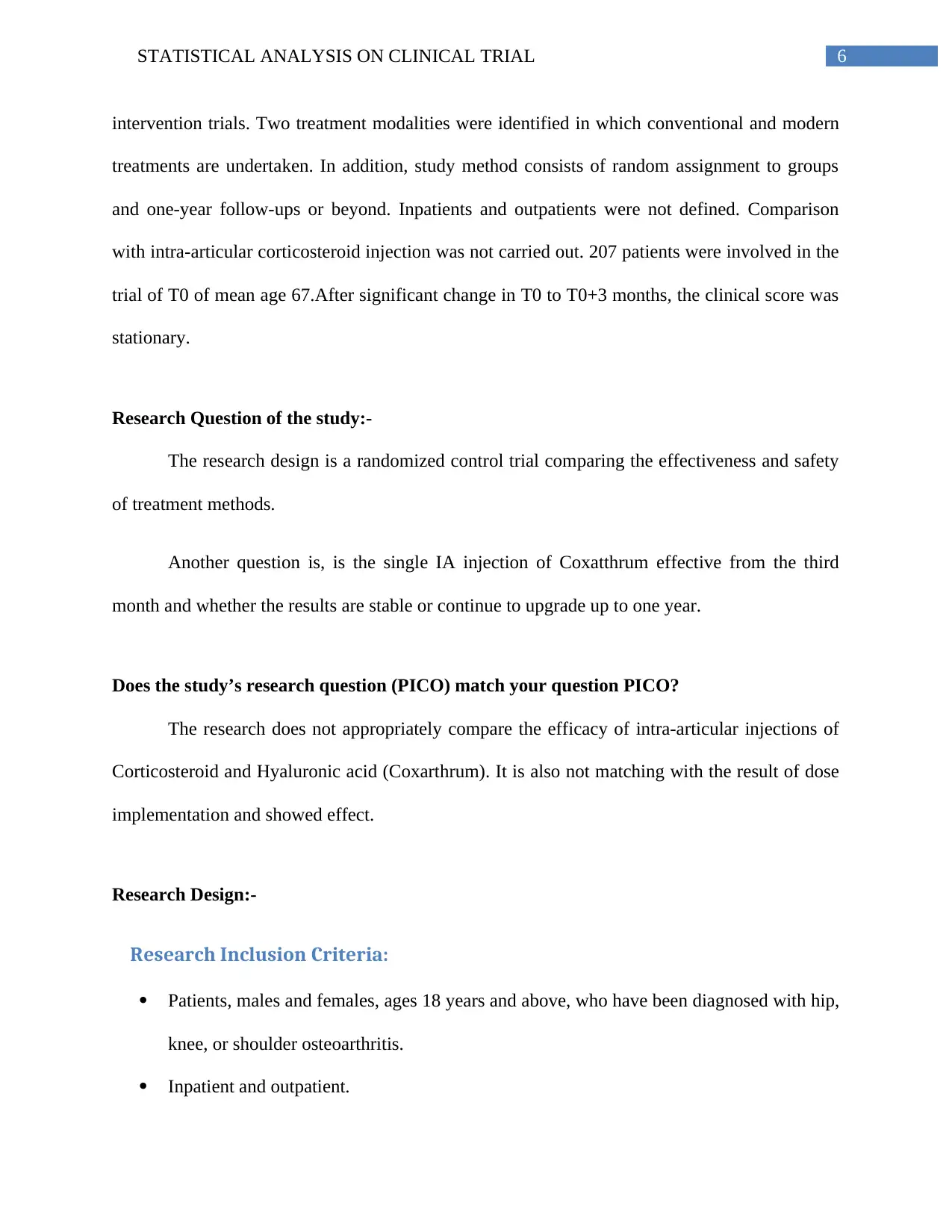
6STATISTICAL ANALYSIS ON CLINICAL TRIAL
intervention trials. Two treatment modalities were identified in which conventional and modern
treatments are undertaken. In addition, study method consists of random assignment to groups
and one-year follow-ups or beyond. Inpatients and outpatients were not defined. Comparison
with intra-articular corticosteroid injection was not carried out. 207 patients were involved in the
trial of T0 of mean age 67.After significant change in T0 to T0+3 months, the clinical score was
stationary.
Research Question of the study:-
The research design is a randomized control trial comparing the effectiveness and safety
of treatment methods.
Another question is, is the single IA injection of Coxatthrum effective from the third
month and whether the results are stable or continue to upgrade up to one year.
Does the study’s research question (PICO) match your question PICO?
The research does not appropriately compare the efficacy of intra-articular injections of
Corticosteroid and Hyaluronic acid (Coxarthrum). It is also not matching with the result of dose
implementation and showed effect.
Research Design:-
Research Inclusion Criteria:
Patients, males and females, ages 18 years and above, who have been diagnosed with hip,
knee, or shoulder osteoarthritis.
Inpatient and outpatient.
intervention trials. Two treatment modalities were identified in which conventional and modern
treatments are undertaken. In addition, study method consists of random assignment to groups
and one-year follow-ups or beyond. Inpatients and outpatients were not defined. Comparison
with intra-articular corticosteroid injection was not carried out. 207 patients were involved in the
trial of T0 of mean age 67.After significant change in T0 to T0+3 months, the clinical score was
stationary.
Research Question of the study:-
The research design is a randomized control trial comparing the effectiveness and safety
of treatment methods.
Another question is, is the single IA injection of Coxatthrum effective from the third
month and whether the results are stable or continue to upgrade up to one year.
Does the study’s research question (PICO) match your question PICO?
The research does not appropriately compare the efficacy of intra-articular injections of
Corticosteroid and Hyaluronic acid (Coxarthrum). It is also not matching with the result of dose
implementation and showed effect.
Research Design:-
Research Inclusion Criteria:
Patients, males and females, ages 18 years and above, who have been diagnosed with hip,
knee, or shoulder osteoarthritis.
Inpatient and outpatient.
Paraphrase This Document
Need a fresh take? Get an instant paraphrase of this document with our AI Paraphraser
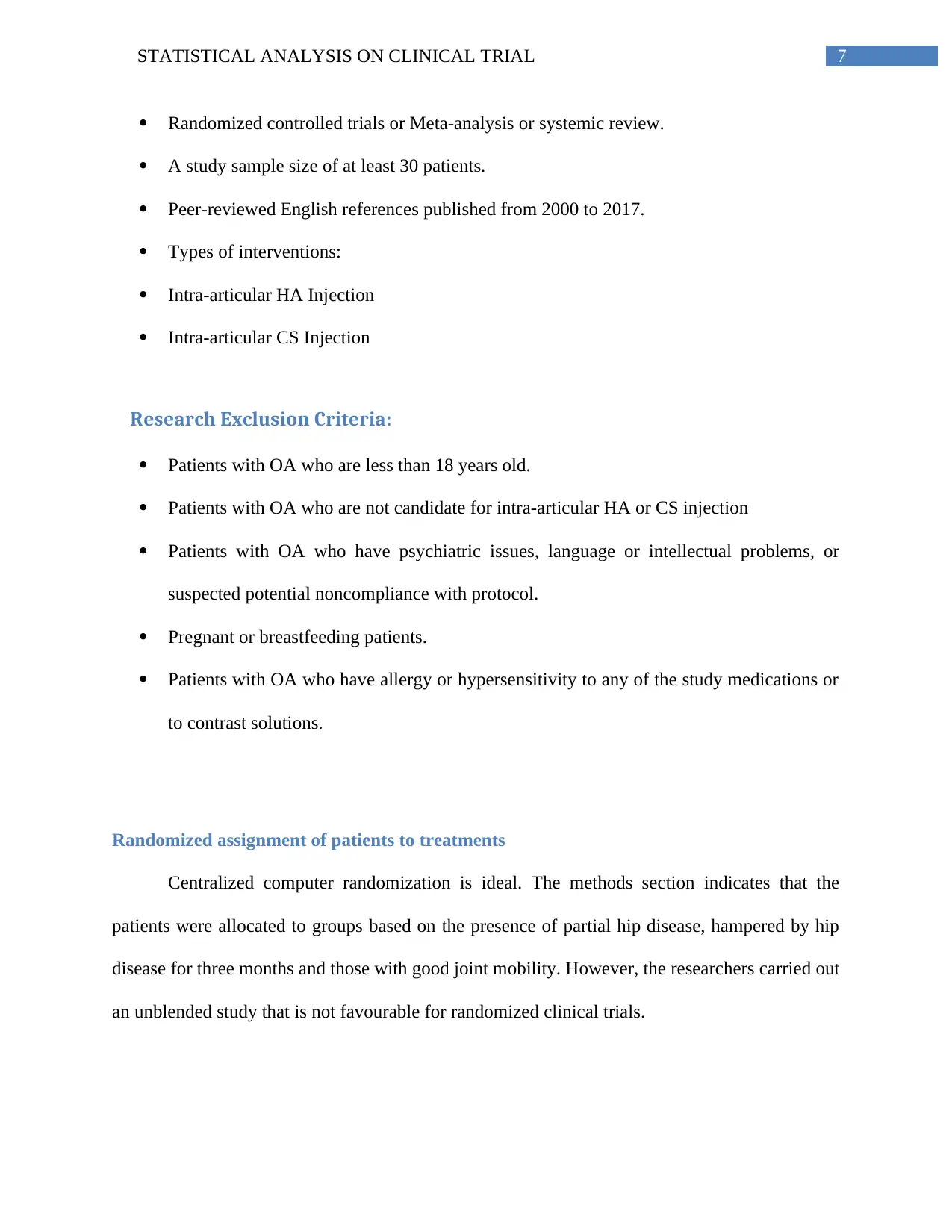
7STATISTICAL ANALYSIS ON CLINICAL TRIAL
Randomized controlled trials or Meta-analysis or systemic review.
A study sample size of at least 30 patients.
Peer-reviewed English references published from 2000 to 2017.
Types of interventions:
Intra-articular HA Injection
Intra-articular CS Injection
Research Exclusion Criteria:
Patients with OA who are less than 18 years old.
Patients with OA who are not candidate for intra-articular HA or CS injection
Patients with OA who have psychiatric issues, language or intellectual problems, or
suspected potential noncompliance with protocol.
Pregnant or breastfeeding patients.
Patients with OA who have allergy or hypersensitivity to any of the study medications or
to contrast solutions.
Randomized assignment of patients to treatments
Centralized computer randomization is ideal. The methods section indicates that the
patients were allocated to groups based on the presence of partial hip disease, hampered by hip
disease for three months and those with good joint mobility. However, the researchers carried out
an unblended study that is not favourable for randomized clinical trials.
Randomized controlled trials or Meta-analysis or systemic review.
A study sample size of at least 30 patients.
Peer-reviewed English references published from 2000 to 2017.
Types of interventions:
Intra-articular HA Injection
Intra-articular CS Injection
Research Exclusion Criteria:
Patients with OA who are less than 18 years old.
Patients with OA who are not candidate for intra-articular HA or CS injection
Patients with OA who have psychiatric issues, language or intellectual problems, or
suspected potential noncompliance with protocol.
Pregnant or breastfeeding patients.
Patients with OA who have allergy or hypersensitivity to any of the study medications or
to contrast solutions.
Randomized assignment of patients to treatments
Centralized computer randomization is ideal. The methods section indicates that the
patients were allocated to groups based on the presence of partial hip disease, hampered by hip
disease for three months and those with good joint mobility. However, the researchers carried out
an unblended study that is not favourable for randomized clinical trials.
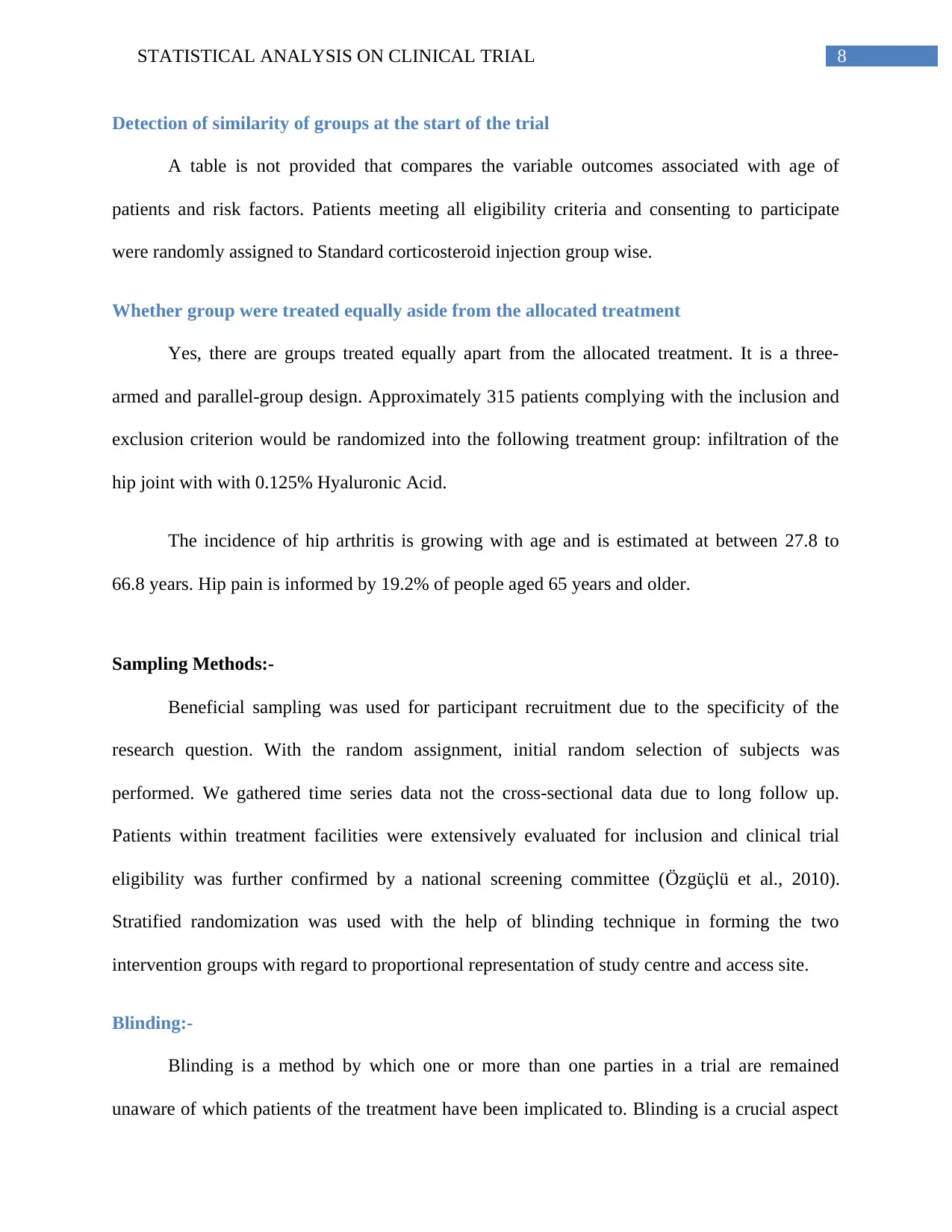
8STATISTICAL ANALYSIS ON CLINICAL TRIAL
Detection of similarity of groups at the start of the trial
A table is not provided that compares the variable outcomes associated with age of
patients and risk factors. Patients meeting all eligibility criteria and consenting to participate
were randomly assigned to Standard corticosteroid injection group wise.
Whether group were treated equally aside from the allocated treatment
Yes, there are groups treated equally apart from the allocated treatment. It is a three-
armed and parallel-group design. Approximately 315 patients complying with the inclusion and
exclusion criterion would be randomized into the following treatment group: infiltration of the
hip joint with with 0.125% Hyaluronic Acid.
The incidence of hip arthritis is growing with age and is estimated at between 27.8 to
66.8 years. Hip pain is informed by 19.2% of people aged 65 years and older.
Sampling Methods:-
Beneficial sampling was used for participant recruitment due to the specificity of the
research question. With the random assignment, initial random selection of subjects was
performed. We gathered time series data not the cross-sectional data due to long follow up.
Patients within treatment facilities were extensively evaluated for inclusion and clinical trial
eligibility was further confirmed by a national screening committee (Özgüçlü et al., 2010).
Stratified randomization was used with the help of blinding technique in forming the two
intervention groups with regard to proportional representation of study centre and access site.
Blinding:-
Blinding is a method by which one or more than one parties in a trial are remained
unaware of which patients of the treatment have been implicated to. Blinding is a crucial aspect
Detection of similarity of groups at the start of the trial
A table is not provided that compares the variable outcomes associated with age of
patients and risk factors. Patients meeting all eligibility criteria and consenting to participate
were randomly assigned to Standard corticosteroid injection group wise.
Whether group were treated equally aside from the allocated treatment
Yes, there are groups treated equally apart from the allocated treatment. It is a three-
armed and parallel-group design. Approximately 315 patients complying with the inclusion and
exclusion criterion would be randomized into the following treatment group: infiltration of the
hip joint with with 0.125% Hyaluronic Acid.
The incidence of hip arthritis is growing with age and is estimated at between 27.8 to
66.8 years. Hip pain is informed by 19.2% of people aged 65 years and older.
Sampling Methods:-
Beneficial sampling was used for participant recruitment due to the specificity of the
research question. With the random assignment, initial random selection of subjects was
performed. We gathered time series data not the cross-sectional data due to long follow up.
Patients within treatment facilities were extensively evaluated for inclusion and clinical trial
eligibility was further confirmed by a national screening committee (Özgüçlü et al., 2010).
Stratified randomization was used with the help of blinding technique in forming the two
intervention groups with regard to proportional representation of study centre and access site.
Blinding:-
Blinding is a method by which one or more than one parties in a trial are remained
unaware of which patients of the treatment have been implicated to. Blinding is a crucial aspect
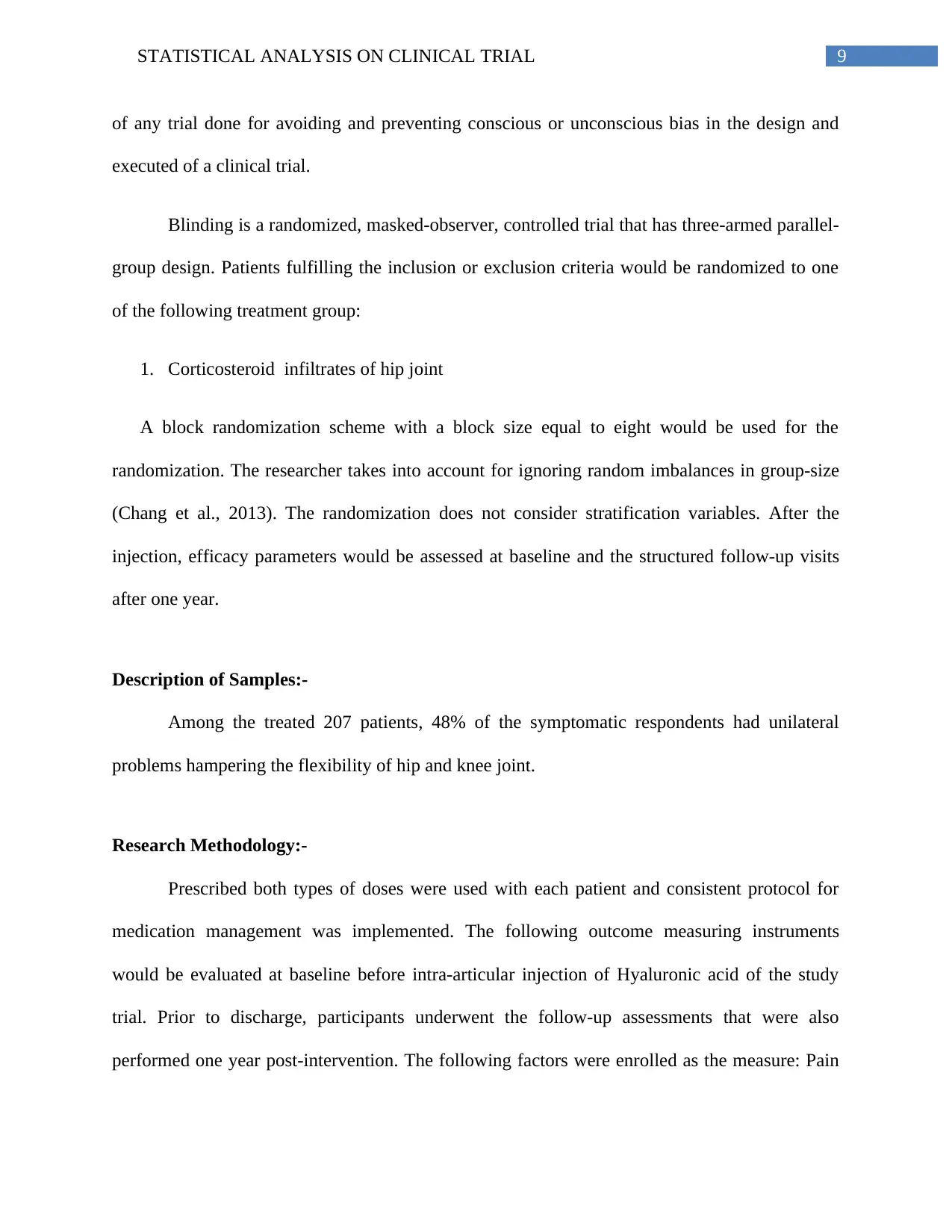
9STATISTICAL ANALYSIS ON CLINICAL TRIAL
of any trial done for avoiding and preventing conscious or unconscious bias in the design and
executed of a clinical trial.
Blinding is a randomized, masked-observer, controlled trial that has three-armed parallel-
group design. Patients fulfilling the inclusion or exclusion criteria would be randomized to one
of the following treatment group:
1. Corticosteroid infiltrates of hip joint
A block randomization scheme with a block size equal to eight would be used for the
randomization. The researcher takes into account for ignoring random imbalances in group-size
(Chang et al., 2013). The randomization does not consider stratification variables. After the
injection, efficacy parameters would be assessed at baseline and the structured follow-up visits
after one year.
Description of Samples:-
Among the treated 207 patients, 48% of the symptomatic respondents had unilateral
problems hampering the flexibility of hip and knee joint.
Research Methodology:-
Prescribed both types of doses were used with each patient and consistent protocol for
medication management was implemented. The following outcome measuring instruments
would be evaluated at baseline before intra-articular injection of Hyaluronic acid of the study
trial. Prior to discharge, participants underwent the follow-up assessments that were also
performed one year post-intervention. The following factors were enrolled as the measure: Pain
of any trial done for avoiding and preventing conscious or unconscious bias in the design and
executed of a clinical trial.
Blinding is a randomized, masked-observer, controlled trial that has three-armed parallel-
group design. Patients fulfilling the inclusion or exclusion criteria would be randomized to one
of the following treatment group:
1. Corticosteroid infiltrates of hip joint
A block randomization scheme with a block size equal to eight would be used for the
randomization. The researcher takes into account for ignoring random imbalances in group-size
(Chang et al., 2013). The randomization does not consider stratification variables. After the
injection, efficacy parameters would be assessed at baseline and the structured follow-up visits
after one year.
Description of Samples:-
Among the treated 207 patients, 48% of the symptomatic respondents had unilateral
problems hampering the flexibility of hip and knee joint.
Research Methodology:-
Prescribed both types of doses were used with each patient and consistent protocol for
medication management was implemented. The following outcome measuring instruments
would be evaluated at baseline before intra-articular injection of Hyaluronic acid of the study
trial. Prior to discharge, participants underwent the follow-up assessments that were also
performed one year post-intervention. The following factors were enrolled as the measure: Pain
Secure Best Marks with AI Grader
Need help grading? Try our AI Grader for instant feedback on your assignments.
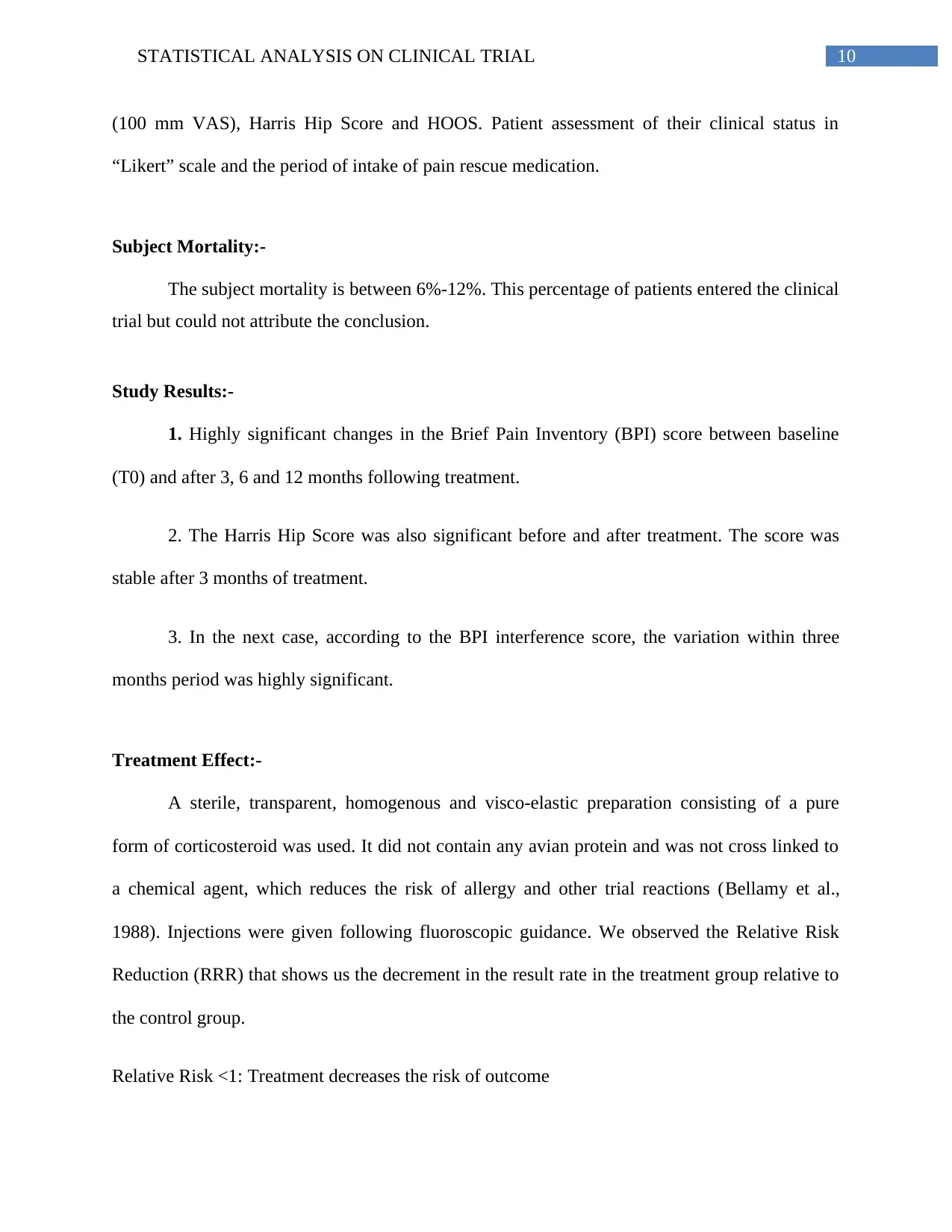
10STATISTICAL ANALYSIS ON CLINICAL TRIAL
(100 mm VAS), Harris Hip Score and HOOS. Patient assessment of their clinical status in
“Likert” scale and the period of intake of pain rescue medication.
Subject Mortality:-
The subject mortality is between 6%-12%. This percentage of patients entered the clinical
trial but could not attribute the conclusion.
Study Results:-
1. Highly significant changes in the Brief Pain Inventory (BPI) score between baseline
(T0) and after 3, 6 and 12 months following treatment.
2. The Harris Hip Score was also significant before and after treatment. The score was
stable after 3 months of treatment.
3. In the next case, according to the BPI interference score, the variation within three
months period was highly significant.
Treatment Effect:-
A sterile, transparent, homogenous and visco-elastic preparation consisting of a pure
form of corticosteroid was used. It did not contain any avian protein and was not cross linked to
a chemical agent, which reduces the risk of allergy and other trial reactions (Bellamy et al.,
1988). Injections were given following fluoroscopic guidance. We observed the Relative Risk
Reduction (RRR) that shows us the decrement in the result rate in the treatment group relative to
the control group.
Relative Risk <1: Treatment decreases the risk of outcome
(100 mm VAS), Harris Hip Score and HOOS. Patient assessment of their clinical status in
“Likert” scale and the period of intake of pain rescue medication.
Subject Mortality:-
The subject mortality is between 6%-12%. This percentage of patients entered the clinical
trial but could not attribute the conclusion.
Study Results:-
1. Highly significant changes in the Brief Pain Inventory (BPI) score between baseline
(T0) and after 3, 6 and 12 months following treatment.
2. The Harris Hip Score was also significant before and after treatment. The score was
stable after 3 months of treatment.
3. In the next case, according to the BPI interference score, the variation within three
months period was highly significant.
Treatment Effect:-
A sterile, transparent, homogenous and visco-elastic preparation consisting of a pure
form of corticosteroid was used. It did not contain any avian protein and was not cross linked to
a chemical agent, which reduces the risk of allergy and other trial reactions (Bellamy et al.,
1988). Injections were given following fluoroscopic guidance. We observed the Relative Risk
Reduction (RRR) that shows us the decrement in the result rate in the treatment group relative to
the control group.
Relative Risk <1: Treatment decreases the risk of outcome
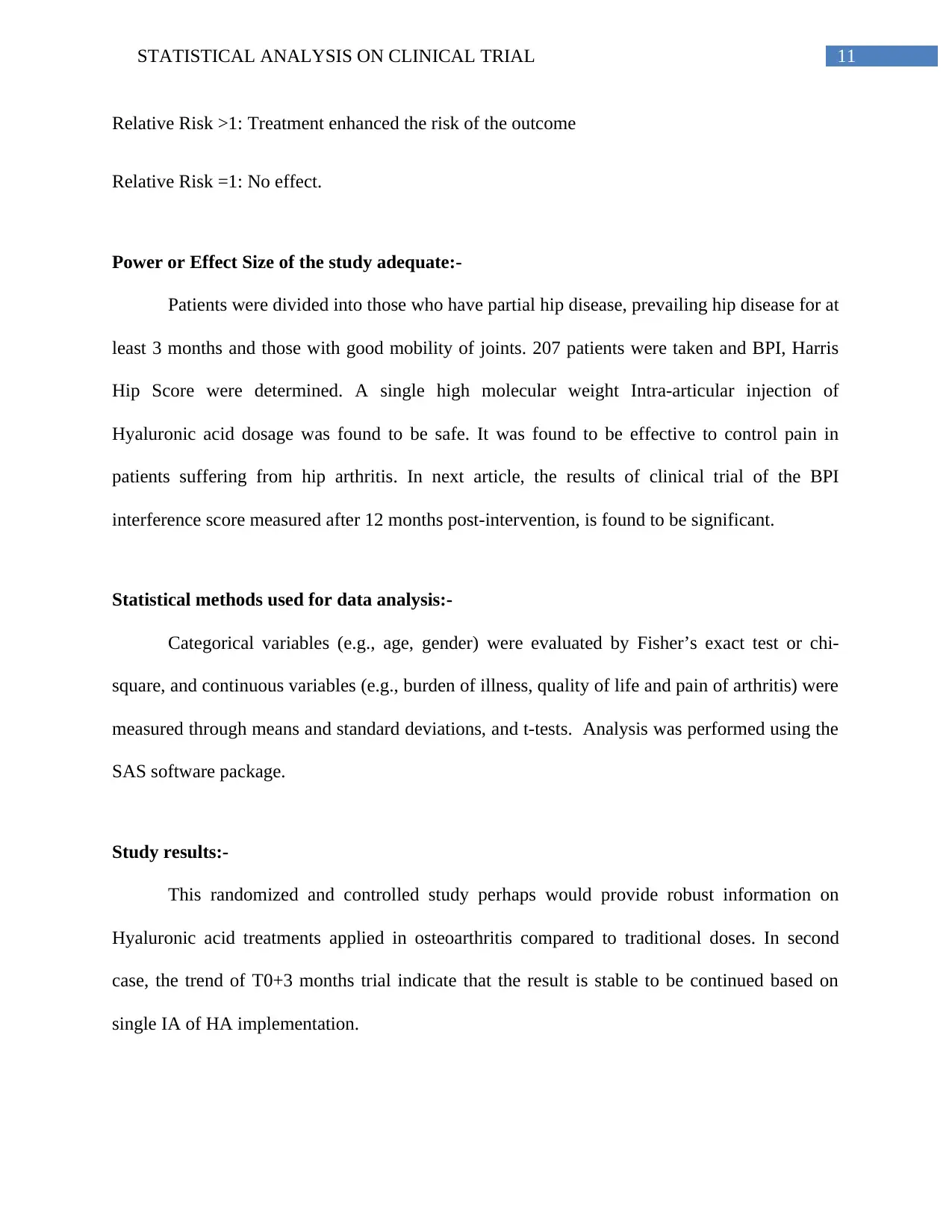
11STATISTICAL ANALYSIS ON CLINICAL TRIAL
Relative Risk >1: Treatment enhanced the risk of the outcome
Relative Risk =1: No effect.
Power or Effect Size of the study adequate:-
Patients were divided into those who have partial hip disease, prevailing hip disease for at
least 3 months and those with good mobility of joints. 207 patients were taken and BPI, Harris
Hip Score were determined. A single high molecular weight Intra-articular injection of
Hyaluronic acid dosage was found to be safe. It was found to be effective to control pain in
patients suffering from hip arthritis. In next article, the results of clinical trial of the BPI
interference score measured after 12 months post-intervention, is found to be significant.
Statistical methods used for data analysis:-
Categorical variables (e.g., age, gender) were evaluated by Fisher’s exact test or chi-
square, and continuous variables (e.g., burden of illness, quality of life and pain of arthritis) were
measured through means and standard deviations, and t-tests. Analysis was performed using the
SAS software package.
Study results:-
This randomized and controlled study perhaps would provide robust information on
Hyaluronic acid treatments applied in osteoarthritis compared to traditional doses. In second
case, the trend of T0+3 months trial indicate that the result is stable to be continued based on
single IA of HA implementation.
Relative Risk >1: Treatment enhanced the risk of the outcome
Relative Risk =1: No effect.
Power or Effect Size of the study adequate:-
Patients were divided into those who have partial hip disease, prevailing hip disease for at
least 3 months and those with good mobility of joints. 207 patients were taken and BPI, Harris
Hip Score were determined. A single high molecular weight Intra-articular injection of
Hyaluronic acid dosage was found to be safe. It was found to be effective to control pain in
patients suffering from hip arthritis. In next article, the results of clinical trial of the BPI
interference score measured after 12 months post-intervention, is found to be significant.
Statistical methods used for data analysis:-
Categorical variables (e.g., age, gender) were evaluated by Fisher’s exact test or chi-
square, and continuous variables (e.g., burden of illness, quality of life and pain of arthritis) were
measured through means and standard deviations, and t-tests. Analysis was performed using the
SAS software package.
Study results:-
This randomized and controlled study perhaps would provide robust information on
Hyaluronic acid treatments applied in osteoarthritis compared to traditional doses. In second
case, the trend of T0+3 months trial indicate that the result is stable to be continued based on
single IA of HA implementation.
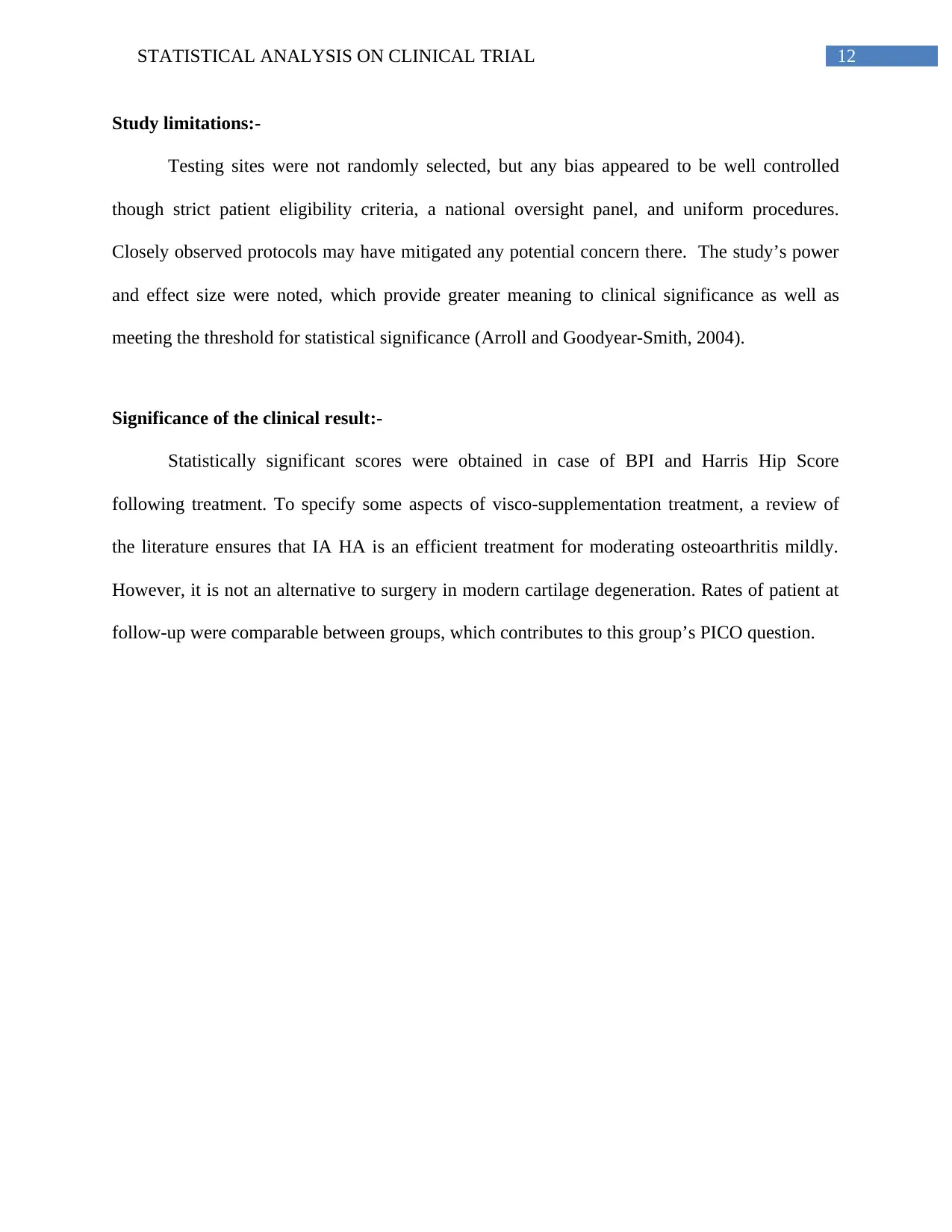
12STATISTICAL ANALYSIS ON CLINICAL TRIAL
Study limitations:-
Testing sites were not randomly selected, but any bias appeared to be well controlled
though strict patient eligibility criteria, a national oversight panel, and uniform procedures.
Closely observed protocols may have mitigated any potential concern there. The study’s power
and effect size were noted, which provide greater meaning to clinical significance as well as
meeting the threshold for statistical significance (Arroll and Goodyear-Smith, 2004).
Significance of the clinical result:-
Statistically significant scores were obtained in case of BPI and Harris Hip Score
following treatment. To specify some aspects of visco-supplementation treatment, a review of
the literature ensures that IA HA is an efficient treatment for moderating osteoarthritis mildly.
However, it is not an alternative to surgery in modern cartilage degeneration. Rates of patient at
follow-up were comparable between groups, which contributes to this group’s PICO question.
Study limitations:-
Testing sites were not randomly selected, but any bias appeared to be well controlled
though strict patient eligibility criteria, a national oversight panel, and uniform procedures.
Closely observed protocols may have mitigated any potential concern there. The study’s power
and effect size were noted, which provide greater meaning to clinical significance as well as
meeting the threshold for statistical significance (Arroll and Goodyear-Smith, 2004).
Significance of the clinical result:-
Statistically significant scores were obtained in case of BPI and Harris Hip Score
following treatment. To specify some aspects of visco-supplementation treatment, a review of
the literature ensures that IA HA is an efficient treatment for moderating osteoarthritis mildly.
However, it is not an alternative to surgery in modern cartilage degeneration. Rates of patient at
follow-up were comparable between groups, which contributes to this group’s PICO question.
Paraphrase This Document
Need a fresh take? Get an instant paraphrase of this document with our AI Paraphraser
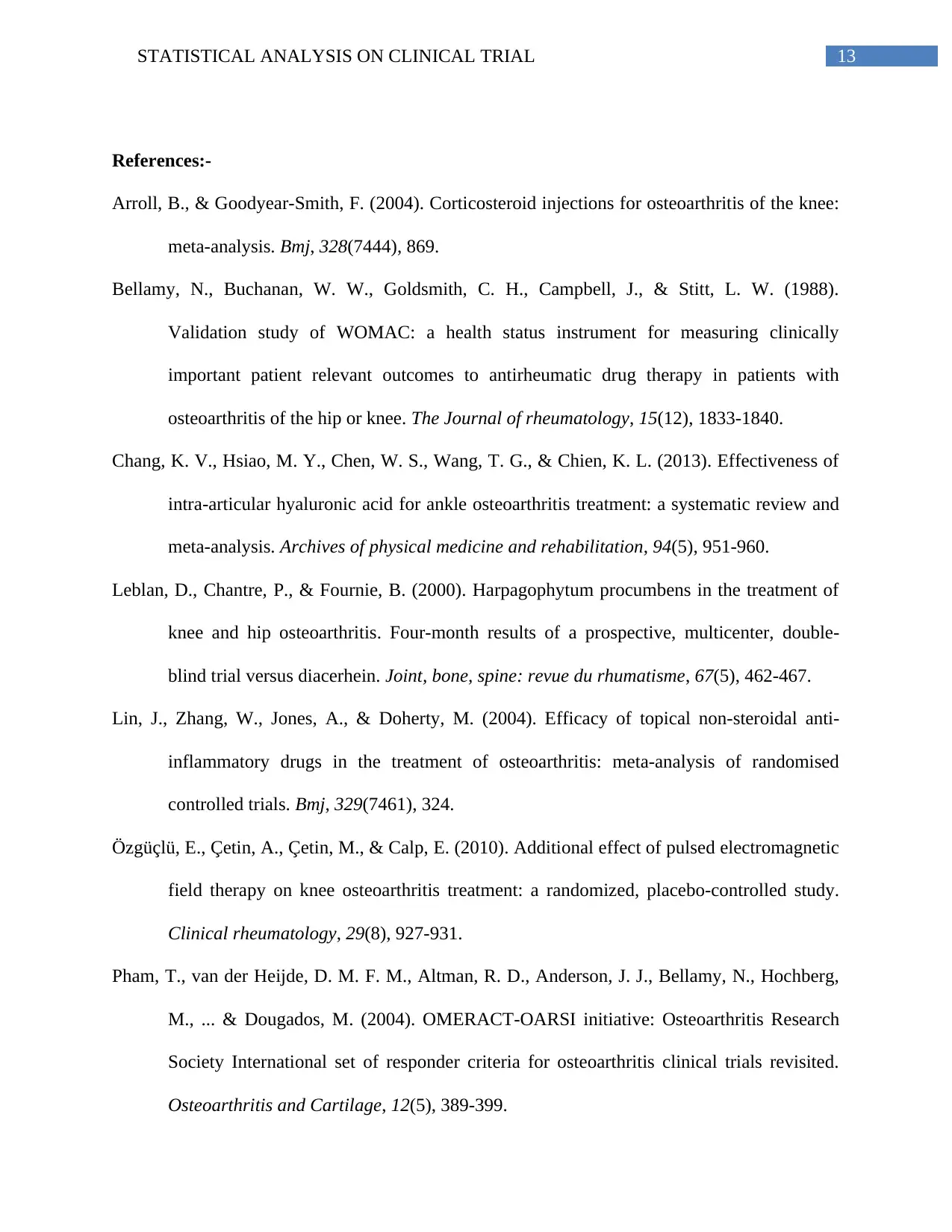
13STATISTICAL ANALYSIS ON CLINICAL TRIAL
References:-
Arroll, B., & Goodyear-Smith, F. (2004). Corticosteroid injections for osteoarthritis of the knee:
meta-analysis. Bmj, 328(7444), 869.
Bellamy, N., Buchanan, W. W., Goldsmith, C. H., Campbell, J., & Stitt, L. W. (1988).
Validation study of WOMAC: a health status instrument for measuring clinically
important patient relevant outcomes to antirheumatic drug therapy in patients with
osteoarthritis of the hip or knee. The Journal of rheumatology, 15(12), 1833-1840.
Chang, K. V., Hsiao, M. Y., Chen, W. S., Wang, T. G., & Chien, K. L. (2013). Effectiveness of
intra-articular hyaluronic acid for ankle osteoarthritis treatment: a systematic review and
meta-analysis. Archives of physical medicine and rehabilitation, 94(5), 951-960.
Leblan, D., Chantre, P., & Fournie, B. (2000). Harpagophytum procumbens in the treatment of
knee and hip osteoarthritis. Four-month results of a prospective, multicenter, double-
blind trial versus diacerhein. Joint, bone, spine: revue du rhumatisme, 67(5), 462-467.
Lin, J., Zhang, W., Jones, A., & Doherty, M. (2004). Efficacy of topical non-steroidal anti-
inflammatory drugs in the treatment of osteoarthritis: meta-analysis of randomised
controlled trials. Bmj, 329(7461), 324.
Özgüçlü, E., Çetin, A., Çetin, M., & Calp, E. (2010). Additional effect of pulsed electromagnetic
field therapy on knee osteoarthritis treatment: a randomized, placebo-controlled study.
Clinical rheumatology, 29(8), 927-931.
Pham, T., van der Heijde, D. M. F. M., Altman, R. D., Anderson, J. J., Bellamy, N., Hochberg,
M., ... & Dougados, M. (2004). OMERACT-OARSI initiative: Osteoarthritis Research
Society International set of responder criteria for osteoarthritis clinical trials revisited.
Osteoarthritis and Cartilage, 12(5), 389-399.
References:-
Arroll, B., & Goodyear-Smith, F. (2004). Corticosteroid injections for osteoarthritis of the knee:
meta-analysis. Bmj, 328(7444), 869.
Bellamy, N., Buchanan, W. W., Goldsmith, C. H., Campbell, J., & Stitt, L. W. (1988).
Validation study of WOMAC: a health status instrument for measuring clinically
important patient relevant outcomes to antirheumatic drug therapy in patients with
osteoarthritis of the hip or knee. The Journal of rheumatology, 15(12), 1833-1840.
Chang, K. V., Hsiao, M. Y., Chen, W. S., Wang, T. G., & Chien, K. L. (2013). Effectiveness of
intra-articular hyaluronic acid for ankle osteoarthritis treatment: a systematic review and
meta-analysis. Archives of physical medicine and rehabilitation, 94(5), 951-960.
Leblan, D., Chantre, P., & Fournie, B. (2000). Harpagophytum procumbens in the treatment of
knee and hip osteoarthritis. Four-month results of a prospective, multicenter, double-
blind trial versus diacerhein. Joint, bone, spine: revue du rhumatisme, 67(5), 462-467.
Lin, J., Zhang, W., Jones, A., & Doherty, M. (2004). Efficacy of topical non-steroidal anti-
inflammatory drugs in the treatment of osteoarthritis: meta-analysis of randomised
controlled trials. Bmj, 329(7461), 324.
Özgüçlü, E., Çetin, A., Çetin, M., & Calp, E. (2010). Additional effect of pulsed electromagnetic
field therapy on knee osteoarthritis treatment: a randomized, placebo-controlled study.
Clinical rheumatology, 29(8), 927-931.
Pham, T., van der Heijde, D. M. F. M., Altman, R. D., Anderson, J. J., Bellamy, N., Hochberg,
M., ... & Dougados, M. (2004). OMERACT-OARSI initiative: Osteoarthritis Research
Society International set of responder criteria for osteoarthritis clinical trials revisited.
Osteoarthritis and Cartilage, 12(5), 389-399.

14STATISTICAL ANALYSIS ON CLINICAL TRIAL
Zhang, W., Moskowitz, R. W., Nuki, G., Abramson, S., Altman, R. D., Arden, N., ... &
Dougados, M. (2007). OARSI recommendations for the management of hip and knee
osteoarthritis, part I: critical appraisal of existing treatment guidelines and systematic
review of current research evidence. Osteoarthritis and cartilage, 15(9), 981-1000.
Zhang, W., Moskowitz, R. W., Nuki, G., Abramson, S., Altman, R. D., Arden, N., ... &
Dougados, M. (2007). OARSI recommendations for the management of hip and knee
osteoarthritis, part I: critical appraisal of existing treatment guidelines and systematic
review of current research evidence. Osteoarthritis and cartilage, 15(9), 981-1000.
1 out of 15
Related Documents
Your All-in-One AI-Powered Toolkit for Academic Success.
+13062052269
info@desklib.com
Available 24*7 on WhatsApp / Email
![[object Object]](/_next/static/media/star-bottom.7253800d.svg)
Unlock your academic potential
© 2024 | Zucol Services PVT LTD | All rights reserved.




